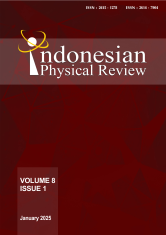INTEGRATION OF SOLAR PANELS AND ARDUINO FOR AQUAPONIC SYSTEM AUTOMATION AND SOLAR ENERGY EFFICIENCY
DOI:
10.29303/ipr.v8i1.415Downloads
Additional Files
Abstract
Aquaponics is a system that combines fish and plant farming in one mutually beneficial ecosystem. However, the consumption of electrical energy, such as driving water pumps in aquaponic systems, is crucial because it requires considerable financing. Solar panels are one of the alternatives in reducing the use of electrical energy. Solar energy is environmentally friendly and does not produce pollution like conventional energy. Thus, automation and using solar energy as renewable energy can be a solution to improving the efficiency of aquaponic systems. This research aims to analyze the Arduino-based automation system and the use of 200 Wp solar panels in aquaponics involving catfish and water spinach cultivation. The system uses solar panels as the primary energy source stored in VRLA batteries, regulated through a Solar Charge Controller, and converted into AC electricity to operate the water pump and automatic monitoring system. Arduino Uno controls the automation and monitoring with pH, TDS, temperature, humidity, and ultrasonic sensors to monitor environmental conditions. Tests show that the solar panel produces an average voltage of 40.83 V and a current of 3.28 A, with an efficiency of 40.65% and a power that can be generated in a day of 1200 Watts. The operational cost of the solar panel system was calculated using the Levelized Cost of Energy (LCOE), showing that it is more efficient than PLN electricity at Rp 688.15/kWh vs. Rp 1,444.70/kWh or Rp 31,397.3 vs. Rp 65,947.35 for one year of aquaponic system use. Monitoring for 10 days showed optimal growth of water spinach and catfish plants with consistent pH, temperature, humidity, and pump and servo operation. The results indicate that an aquaponics system powered by renewable energy and Arduino-based automation effectively meets energy needs at a lower cost and improves the efficiency and reliability of aquaponics operations.Keywords:
Aquaponics Solar Energy Energy Efficiency Automated Systems Renewable EnergyReferences
R. E. S. Dauhan and E. Efendi, “Efektifitas sistem akuaponik dalam mereduksi konsentrasi amonia pada sistem budidaya ikan,†E-Jurnal rekayasa dan teknologi budidaya perairan, vol. 3, no. 1, pp. 297–302, 2014.
N. F. Farida, S. H. Abdullah, and A. Priyati, “Analisis kualitas air pada sistem pengairan akuaponik [analysis of water quality in Aquaponic Irrigation System],†Jurnal Ilmiah Rekayasa Pertanian dan Biosistem, vol. 5, no. 2, pp. 385–394, 2017.
Y. Rahmanto, A. Burlian, and S. Samsugi, “Sistem Kendali Otomatis Pada Akuaponik Berbasis Mikrokontroler Arduino Uno R3,†Jurnal Teknologi Dan Sistem Tertanam, vol. 2, no. 1, pp. 1–6, 2021, doi: https://doi.org/10.33365/jtst.v2i1.975.
S. Goddek, B. Delaide, U. Mankasingh, K. V. Ragnarsdottir, H. Jijakli, and R. Thorarinsdottir, “Challenges of sustainable and commercial aquaponics,†Sustainability, vol. 7, no. 4, pp. 4199–4224, 2015.
Y. Chandra, “Perancangan Pembangkit Listrik Tenaga Surya (PLTS) Sebagai Sumber Energi Listrik Untuk Akuaponik,†Electrical Network Systems and Sources, vol. 1, no. 1, pp. 19–24, 2022.
T. F. Andansari, M. A. Habibi, I. Alfianto, S. N. Maharani, M. Yazid, and A. Wibawa, “Instalasi plts hybrid untuk akuaponik Sengkaling,†at-tamkin: Jurnal Pengabdian kepada Masyarakat, vol. 5, no. 2, pp. 24–37, 2022.
B. Hartono and Purwanto, “Perancangan Pompa Air Tenaga Surya Guna Memindahkan Air Bersih ke Tangki Penampung,†Jurnal Ilmiah Teknik Mesin, vol. 9, no. 1, pp. 28–33, 2015.
Y. P. Efendy, D. Y. Qadlizaka, R. R. Raihanfalaach, and N. Azizah, “Penerapan Teknologi Budidaya Akuaponik Sebagai Bentuk Pemanfaatan Lahan Sempit di Kelurahan Jambangan, Surabaya,†KARYA UNGGUL-Jurnal Pengabdian Kepada Masyarakat, vol. 1, no. 2, pp. 62–68, 2022.
Z. Hasan, Y. Andriani, Y. Dhahiyat, A. Sahidin, and M. R. Rubiansyah, “Growth of different strains of three fishes and water spinach (Ipomoea reptans Poir) based aquaponic,†J Iktiologi Indones, vol. 17, no. 2, pp. 175–184, 2017.
R. A. Nugroho, L. T. Pambudi, D. Chilmawati, and A. H. C. Haditomo, “Aplikasi teknologi aquaponic pada budidaya ikan air tawar untuk optimalisasi kapasitas produksi,†Jurnal saintek perikanan, vol. 8, no. 1, 2012.
L. E. Rahmadhani, L. I. Widuri, and P. Dewanti, “Kualitas mutu sayur kasepak (kangkung, selada, dan pakcoy) dengan sistem budidaya akuaponik dan hidroponik,†Jurnal Agroteknologi, vol. 14, no. 01, pp. 33–43, 2020.
M. I. Nasution, L. H. Lubis, and W. U. A. Ritonga, “Implementasi Mikrokontroler Berbasis IoT untuk Optimalisasi Kinerja Sistem Akuaponik,†Phi: Jurnal Pendidikan Fisika dan Terapan, vol. 9, no. 1, pp. 7–14, 2023.
D. Karimanzira and T. Rauschenbach, “Optimal utilization of renewable energy in aquaponic systems,†Energy Power Eng, vol. 10, no. 06, pp. 279–300, 2018.
N. Huda, “Energi Baru Terbarukan Solar Cell Sederhana Untuk Sistem Penerangan Rumah Tangga,†Cahaya Bagaskara: Jurnal Ilmiah Teknik Elektronika, vol. 3, no. 1, pp. 6–10, 2018.
M. Djamin, “Penelitian penerapan pembangkit listrik tenaga surya dan dampaknya terhadap lingkungan,†Jurnal Teknologi Lingkungan, vol. 11, no. 2, pp. 221–225, 2010.
B. H. Purwoto, J. Jatmiko, M. A. Fadilah, and I. F. Huda, “Efisiensi penggunaan panel surya sebagai sumber energi alternatif,†Emitor: Jurnal Teknik Elektro, vol. 18, no. 1, pp. 10–14, 2018.
H. B. Nurjaman and T. Purnama, “Pembangkit Listrik Tenaga Surya (PLTS) sebagai solusi energi terbarukan rumah tangga,†2022, Nov.
N. Arif, S. Suaedi, M. Rahmadi, and F. M. Siregar, “Potensi Energi Surya sebagai Energi Listrik Alternatif berbasis RETScreen di Kota Palopo, Indonesia,†Dewantara Journal of Technology, vol. 1, no. 1, pp. 38–42, 2020.
H. Asy’ari, A. Rozaq, and F. S. Putra, “Pemanfaatan Solar Cell dengan PLN Sebagai Sumber Energi Listrik Rumah Tinggal,†Emitor, vol. 14, no. 01, pp. 33–39, 2014.
A. B. Karaveli, U. Soytas, and B. G. Akinoglu, “Comparison of large-scale solar PV (photovoltaic) and nuclear power plant investments in an emerging market,†Energy, vol. 84, pp. 656–665, 2015.
E. B. Agyekum, V. I. Velkin, and I. Hossain, “Sustainable energy: Is it nuclear or solar for African Countries? Case study on Ghana,†Sustainable Energy Technologies and Assessments, vol. 37, p. 100630, 2020.
Krismadinata, Aprilwan, and A. B. Pulungan, “Rancang Bangun Sistem Monitoring Simulator Modul Surya,†Prosiding - Seminar Nasional Teknik Elektro UIN Sunan Gunung Djati Bandung, no. Seminar Nasional Teknik Elektro UIN Sunan Gunung Djati Bandung (SENTER 2018), pp. 192–201, 2018.
I. Usman, “Penumbuhan Lapisan Tipis Silikon Amorf Terhidrogenasi Dengan Teknik HWC-VHF-PECVD dan Aplikasinya Pada Sel Surya,†Bandung: Institut Teknologi Bandung, 2006.
R. A. M. Napitupulu, S. Simanjuntak, and S. Sibarani, “Pengaruh Material Monokristal dan Polikristal Terhadap Karakteristik Sel Surya 20 Wp dengan tracking sistem Dua Sumbu,†LPPM Universitas HKBP Nommensen Medan, 2017.
J. Hernández-Moro and J. M. Martinez-Duart, “Analytical model for solar PV and CSP electricity costs: Present LCOE values and their future evolution,†Renewable and Sustainable Energy Reviews, vol. 20, pp. 119–132, 2013.
Z. Iqtimal, I. D. Sara, and S. Syahrizal, “Aplikasi sistem tenaga surya sebagai sumber tenaga listrik pompa air,†Jurnal Komputer, Informasi Teknologi, dan Elektro, vol. 3, no. 1, 2018.
D. Dahliya, S. Samsurizal, and N. Pasra, “Efisiensi panel surya kapasitas 100 wp akibat pengaruh suhu dan kecepatan angin,†Sutet, vol. 11, no. 2, pp. 71–80, 2021.
A. Asrori and E. Yudiyanto, “Kajian Karakteristik Temperatur Permukaan Panel Terhadap Performansi Instalasi Panel Surya Tipe Mono dan Polikristal,†FLYWHEEL: Jurnal Teknik Mesin Untirta, vol. 1, no. 1, pp. 68–73, 2019.
Y. I. Lukmato, Muhammad Jubran Rizqullah, Mohamad Wahyu Hidayat, and Siti Diah Ayu Febriani, “Analisis Losses Daya Sel Surya dalam Fabrikasi Modul Surya Monocrystalline 330Wp Pt Santinilestari Energi Indonesia,†Jurnal Inovasi Teknologi Manufaktur, Energi dan Otomotif, vol. 1, no. 1, pp. 37–44, 2022, doi: 10.57203/jinggo. v1i1.2022.37-44.
S. Rizal, “pengaruh Nutrisi Terhadap Pertumbuhan Tanaman Sawi Pakcoy (Brasicca rapa L.) yang di Tanam Secara Hidroponik,†Sainmatika, vol. 14, no. 1, pp. 38–44, 2017.
B. Delaide, S. Goddek, J. Gott, H. Soyeurt, and M. H. Jijakli, “Lettuce (Lactuca sativa L. var. Sucrine) Growth Performance in Complemented Aquaponic Solution Outperforms Hydroponics,†Water (Switzerland), vol. 8, no. 10, pp. 1–11, 2016, doi: 10.3390/w8100467.
L. H. Pratopo and A. Thoriq, “Produksi Tanaman Kangkung dan Ikan Lele dengan Sistem Akuaponik,†Paspalum: Jurnal Ilmiah Pertanian, vol. 9, no. 1, pp. 68–76, 2021.
D. Dahliya, S. Samsurizal, and N. Pasra, “Efficiency of a 100 Wp Capacity Solar Panel Due to the Effect of Temperature and Wind Speed,†Jurnal Ilmiah SUTET, vol. 11, no. 2, pp. 71–80, 2021.
S. G. Ramadhan and C. Rangkuti, “Perencanaan Pembangkit Listrik Tenaga Surya Di Atap Gedung Harry Hartanto Universitas Trisakti,†in Prosiding Seminar Nasional Cendekiawan, 2016, pp. 21–22.
License

This work is licensed under a Creative Commons Attribution-NonCommercial-ShareAlike 4.0 International License.
Authors who publish with Indonesian Physical Review Journal, agree to the following terms:
- Authors retain copyright and grant the journal right of first publication with the work simultaneously licensed under a Creative Commons Attribution-ShareAlike 4.0 International Licence (CC BY SA-4.0). This license allows authors to use all articles, data sets, graphics, and appendices in data mining applications, search engines, web sites, blogs, and other platforms by providing an appropriate reference. The journal allows the author(s) to hold the copyright without restrictions and will retain publishing rights without restrictions.
- Authors are able to enter into separate, additional contractual arrangements for the non-exclusive distribution of the journal's published version of the work (e.g., post it to an institutional repository or publish it in a book), with an acknowledgment of its initial publication in Indonesian Physical Review Journal.
- Authors are permitted and encouraged to post their work online (e.g., in institutional repositories or on their website) prior to and during the submission process, as it can lead to productive exchanges, as well as earlier and greater citation of published work (See The Effect of Open Access).





